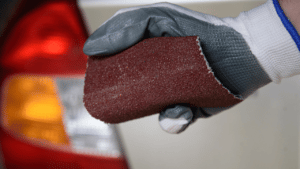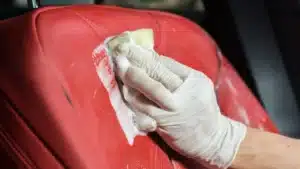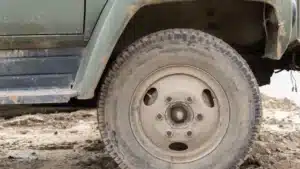Surface preparation is essential for painting or touching up car paint. The correct type of sandpaper can improve adherence and help you achieve a smooth, shiny paint job. The question is: what grit sandpaper for car paint is most effective?
The problem with sanding your car is that there are many different types of sandpaper, and each is suited for a different purpose. If you select the wrong option, you might leave deep scratches on your auto body or, worse, ruin your paint job beyond repair.
The key to getting this part of the preparation correct is selecting the right sandpaper grit.
Here is a look at the options for sandpaper grit and the jobs for which each is best suited.
The Most Common Sand Paper Grits
If you go to a home improvement store, you will see a wide grit range. Sandpaper sheets range from very rough to extremely fine. In general, the coarser the abrasive particles on the sandpaper sheets, the lower the grit number.
Here is a look at the most common options you will encounter in the sandpaper aisle.

40-grit sandpaper
40-grit sandpaper sheets are very coarse. This product is typically for shaping wood or removing the finish on floors or furniture. It typically requires a final sanding with a finer grit to smooth out the surface.
80-grit sandpaper
Medium-grit sandpaper is slightly finer than the coarsest option. It is still rough enough for shaping wood, defining rough edges, or removing finishes from a variety of surfaces. However, when it comes to metal or plastic, this grit can still cause surface damage. Therefore, you do not want to use it on your auto body.
120-180 grit sandpaper
Most of the sheets used for sanding are in the 120-180 grit range. For woodworking and sanding on floors and walls, these varieties are considered fine grit. 180-grit sandpaper is the coarsest option for use on an auto body. You should not use it on paint directly, but it can help in removing rust from your car.
240-grit sandpaper
240-grit sandpaper has more than one use. For wood, it can make a smoother surface during the second or third sanding. For painting some surfaces, such as lacquer, it can roughen glossy paint to improve adherence to the next coats. Finally, it can help remove small rust spots or other imperfections on metal surfaces.
320-grit sandpaper
These ultra-fine sandpaper sheets are typically for smoothing a surface between coats. It is not for shaping or removing imperfections. You typically use these coarse options with a sanding block or electric belt sander.
400-grit sandpaper
This sanding option is considered “very fine.” It is for polishing surfaces, and it comes in waterproof varieties for wet sanding.
600-800-grit sandpaper
These ultra-fine options are also available for wet sanding. They are specifically for polishing metal and wood surfaces to remove tiny imperfections. You can use it after a base coat of paint to improve the sticking of subsequent layers.
1,000-1,200-grit sandpaper
This ultra-fine paper is for sanding fragile surfaces like plastic. It can be useful for painting your car’s plastic bodywork.
1,500-2,000-grit sandpaper
These products are available for wet or dry sanding and are excellent options for buffing. They are gentle enough to polish the clear coat that protects your paint. Like other fine-grit paper, it may only be available at specialty stores.
3,000-grit sandpaper
These finer grits will not leave scratches on the paint during sanding. They are typically for buffing surfaces and may be available at auto parts stores.
5,000-grit sandpaper
5,000 grit sandpaper is another option for auto body polishing. It is also fine enough to work on transparent surfaces. For example, you use it with a palm sander to restore headlights. You can also consider it to remove imperfections or stains from your windshield.
7,000-grit sandpaper
This sandpaper grit is typically the finest available option, even from auto shops. It can work on windows, plastic components, and headlights. It is an option for use between coats while painting, but the difference between this and other ultra-fine grits may not be noticeable.
What Grit Sandpaper for Car Paint?

Options of sandpaper for car paint vary depending on the nature of your painting plans, the surfaces you want to paint, and the condition of the exterior. You can also choose sandpaper grit based on whether you plan to perform dry or wet sanding.
Here is a look at the best sandpaper grit for specific steps during car painting.
What Grit Sandpaper for Primer?
320-grit sheets are the coarsest option for pre-primer sanding on metal car surfaces. However, if you need to remove rust or other types of corrosion before sanding, you can use 180 or 240-grit products. You should not use these options on the entire body. Instead, you should only employ them for sanding off the rusty spots or areas with thick paint. You can then switch to the finer sandpaper grit when preparing the surface for the primer.
After the primer, you can switch to a 600 or 800-grit sheet to remove imperfections, bubbles, or bumps before applying the paint.
What Grit Sandpaper for the Base Coat?
The further you progress with your painting job, the finer the sandpaper grit. After you apply the base coat, you can employ 1,000 to 1,200-grit sheets to smooth the surface and prepare for the second and third layers of paint. For the best results, you should use a block sander or palm sander and rely on a wet sanding technique. This will help you get the desired result and ensure you do not scratch the paint job.
What Grit Sandpaper for Clear Coat?
If you want to remove the clear coat before painting, you can use 400-girt sandpaper and a wet sanding technique. However, after the final paint coat, you will want much finer sandpaper grits. You should use a grit number between 2,000 to 3,000 to remove imperfections from the clear coat after application. If you scratch the clear coat, it won’t provide the proper protection for your paint job, and it won’t provide the level of shine you expect.
How fine should you sand a car before painting?
For most car paint projects, you want to follow a progression from coarser to finer sandpaper grits. The first stage involves 180 to 240-grit sheets for rust removal, if necessary. This paper should not be used over every square inch of the car because it will leave small scratches. Instead, you should only use it on the affected area to remove the rust. If you only have light rust, you can use a finer paper, such as 400 or 600-grit.
If you are using shaping body filler, you will want to apply it first and give it time to dry before you sand. The same applies to other compounds like spot putty. You can apply these substances about a day before your general sanding job. Fine sanding spot putty and body filler can ensure that they blend evenly with the rest of the auto body work.
Rubbing compound is an abrasive material that can also work to remove blemishes on your vehicle. This is an option if you are only trying to touch up the paint and do not want to cover the entire car. Wet sanding is almost always a better option if you want to paint the entire exterior.
You want to make sure the paint sticks. Finer grit paper, usually 600 to 800-grit, works best to remove smaller imperfections and smooth rough surfaces on the body work. You can employ a wet sanding technique using a block sander or a mechanical sander with a sandpaper disc. You will need to sand the entire surface that you plan to paint.
If you are also painting the plastic trim, you will want to use a finer grit number to sand these surfaces. 2,000 grit or higher will work the best. Anything coarser could leave small scratches behind.
1,200 to 2,000-grit sandpaper can also work after the base coat. It can help the subsequent layers stick better and provide a smooth finish. However, you do not want to sand the edges for too long, because it could change the shape in a way that you cannot repair.
3,000 or higher grit sandpaper is best for buffing after painting and before a clear coat. It removes imperfection marks and leaves you with professional results and the desired level of shine for your new paint. This process is also known as color sanding.
How Do You Tell When You’re Done Sanding?
When sanding to prepare for primer or paint, you should cover every square inch of the area you plan to paint. Because you are using a wet sanding technique, you should be able to see the areas where you have already sanded. If you keep moving at an even pace, you will eventually cover the entire area.
What Grit Sandpaper for Car Paint? – FAQs
Here are some common questions that you might have as you proceed to paint your vehicle.
What grit sandpaper is best for sanding a car?
If you are sanding the entire painting surface, you should use at least 600-grit sandpaper and wet sand using water or water and dish soap along with a manual or mechanical sander. If you polish the car after painting, you will want to use 3,000 grit or above. These products are typically available at auto supply stores.
Can I use 2,000-grit sandpaper on the clear coat layer?
2,000-grit is acceptable for use on clear coat finishes. However, you need to be careful not to apply too much pressure, or you will leave small scratches that will require a paint touch-up.
Most auto body experts recommend 2,000 to 3,000-grit sheets for clear coat polishing using a wet sanding method. Anything finer may not produce the desired level of smoothness.
Is 1,000-grit sandpaper fine?
1,000-grit sandpaper is considered ultra-fine for most purposes. For car painting, 1,000-grit is usually too fine for rust removal or prepping the surface for primer before you begin the painting job. However, when it comes to buffing the clear coat, 1,000-grit may actually be too coarse and could leave small scratches on the surface.
What if I sanded too much?
It is certainly possible to sand too much. If you went overboard or chose the wrong grit, you can use touchup paint or body filler to erase the scratches you caused. However, if you choose the right grit for each step and apply even pressure, you can avoid these mistakes in the first place.
Using an electric sander and light pressure can help you get an even result across the entire surface of your car. Even then, you should have body filler or spot putty available to correct any mistakes quickly.
How to Master Sanding when Painting Your Car
Sanding can seem challenging because you are, in essence, rubbing an abrasive material directly against your car. You need to answer the question “what grit sandpaper for car paint” for each step of the process. If you choose the right grit and employ the correct methods for each step from prepping to buffing the clear coat, you can achieve professional results and end up with a newly painted exterior that has the perfect level of smoothness and shine.
Related Content:



